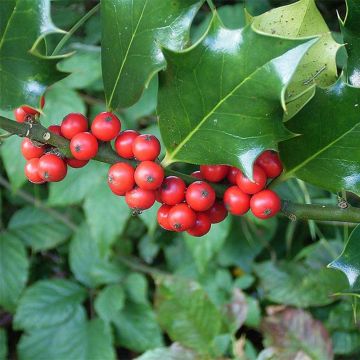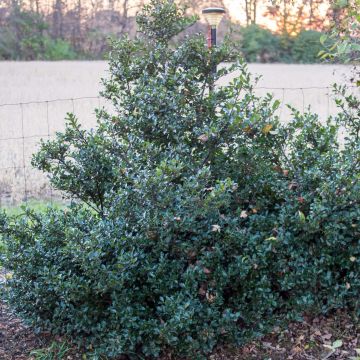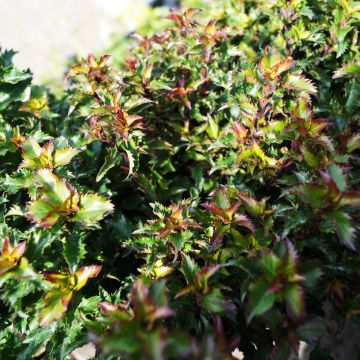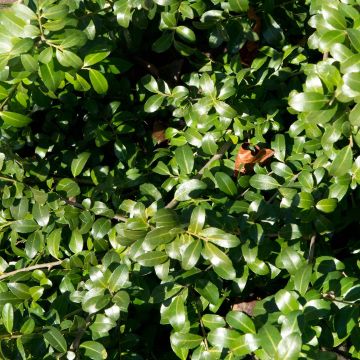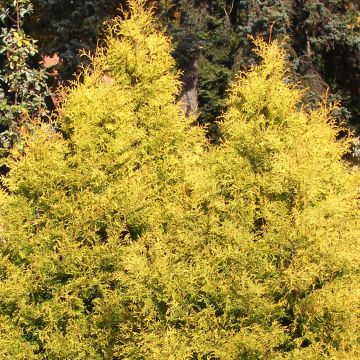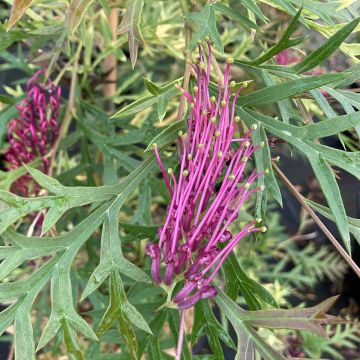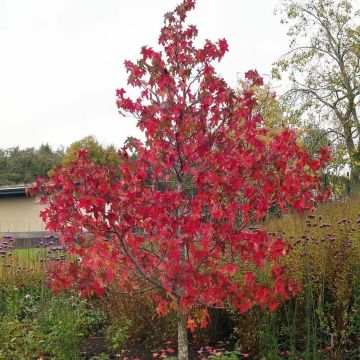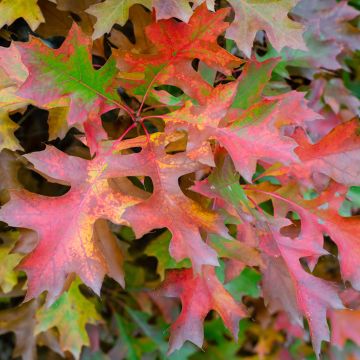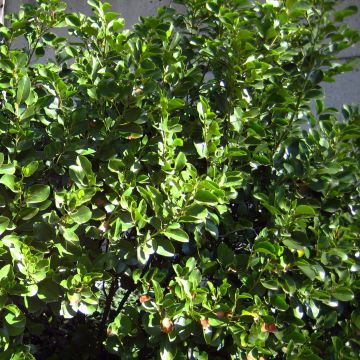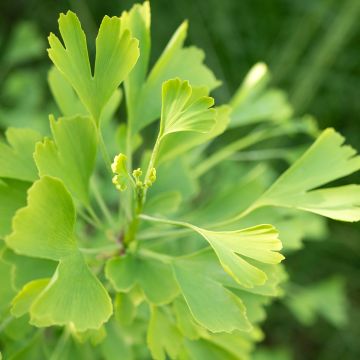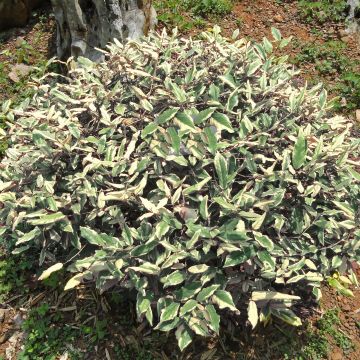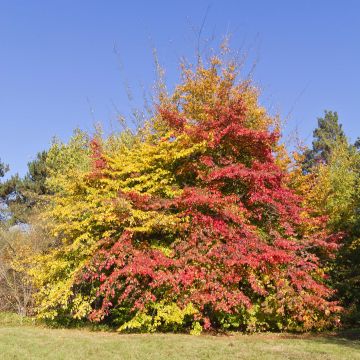

Ilex crenata Convexa - Japanese Holly
Ilex crenata Convexa - Japanese Holly
Ilex crenata Convexa
Japanese Holly, Box-leaved Holly, Box-leaved Ilex, Dwarf Holly
This item cannot be shipped to the selected country
Delivery charge from €5.90
Delivery to Corse prohibited
More information
Schedule delivery date,
and select date in basket
This plant carries a 24 months recovery warranty
More information
We guarantee the quality of our plants for a full growing cycle, and will replace at our expense any plant that fails to recover under normal climatic and planting conditions.
From €5.90 for pickup delivery and €6.90 for home delivery
Express home delivery from €8.90.
Delivery to Corse prohibited: UE law prohibits the import of this plant from mainland France to Corse as part of the fight against Xylella fastidiosa. Please accept our sincere apologies.
More information
Does this plant fit my garden?
Set up your Plantfit profile →
Description
Ilex crenata 'Convexa' is a variety of Japanese holly with relatively slow growth. It features small, non-prickly, glossy green leaves. It is evergreen throughout the year. Its low vigour, dense foliage, and excellent suitability for pruning make it ideal for topiary formation. It is particularly well suited to ball formation, as proposed here. Growing well in semi-shade, or even in the sun, it requires slightly moist, well-drained, neutral to slightly acidic soil. Its good hardiness (-15°C (5°F) approximately) makes it suitable for most regions.
Ilex crenata, the type species, is native to temperate regions of Asia (China, Japan, Russia). It was introduced to Europe in the 19th century.
It bears rigid branches and small, glossy green, convex-shaped leaves resembling the leaves of boxwood and measuring 1 to 3cm (0.4 to 1in) long. Insignificant greenish-white flowers (5mm (0.2in)) appear in May-June. It is a dioecious plant, meaning that a plant is either female or male. In autumn, female plants bear small, shiny black berries, 2 to 6mm (0.1 to 0.2in) that persist all winter. In its native habitat, this bush can exceed 5m (16ft) in height, which is not the case in our gardens.
Left in free form, 'Convexa' will reach 3 to 4m (10 to 13ft) in height and 3m (10ft) in spread in our gardens, but pruned in topiary, its dimensions will be limited according to the desired effect in the garden. Its main quality comes from its dense branches, and its medium green glossy foliage. The slightly dentate (crenate) leaves do not exceed 1 to 2cm (0.4 to 1in). Its growth rate is quite slow, of the order of 15 to 20cm (6 to 8in) per year.
'Convexa' can easily be maintained in a ball shape, by pruning it in spring and a second time in September. With its geometric aspect, this topiary will find its place in Japanese (of which it is a historical component) or contemporary gardens. In summary, this bush is suitable for all gardens where volume and colour take precedence over the individuality of the plant. A particularly interesting visual effect can be obtained in group planting, for example by creating a perfect checkerboard pattern. Juxtaposing 3 or 5 holly balls of different diameters will maximise the volume of these bushes. It will then be enough to let some plants grow for 1 or 2 years, adjusting their shape if necessary, while pruning others to contain their growth. Used as a single specimen, this holly can also be combined with other topiaries, or with structural plants such as columnar conifers with bluish foliage, like Juniperus 'Blue Arrow', to create a contrast in shape and colour. Growing well in slightly acidic soil, many ericaceous plants will make good companions, such as the small Skimmia japonica 'Magic Merlot' with variegated foliage, camellias with their stylised flowers, Japanese maples or the superb Magnolia liliiflora 'Nigra' with its spectacular flowering. It will also be perfect in a beautiful wooden pot (used for orangery plants), or in painted metal, to decorate a terrace or frame a path with several plants.
Report an error about the product description
Ilex crenata Convexa - Japanese Holly in pictures
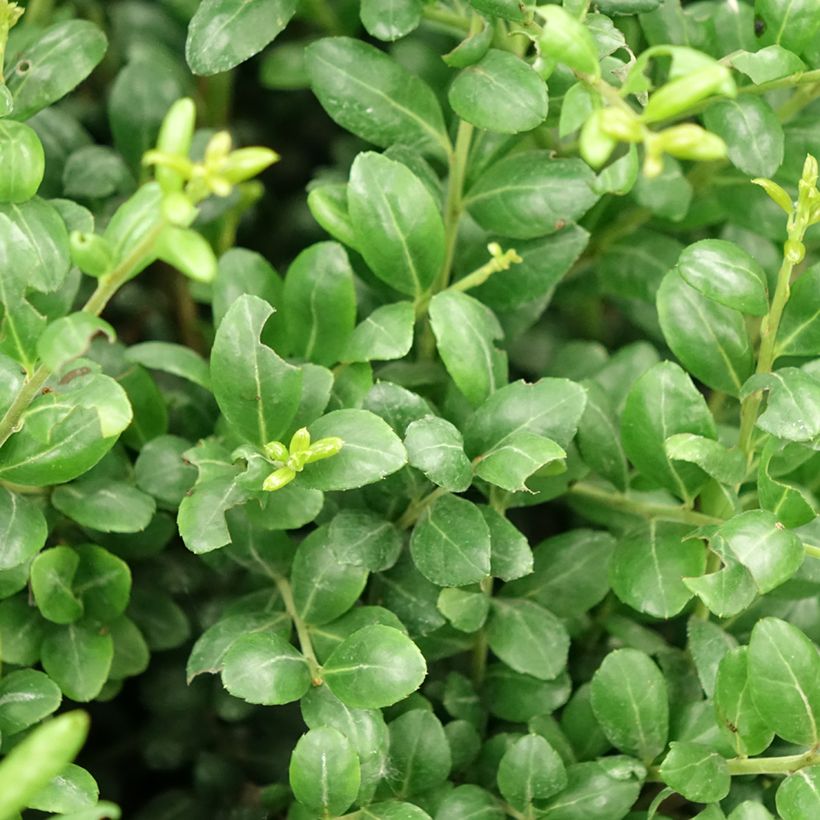

Plant habit
Flowering
Foliage
Botanical data
Ilex
crenata
Convexa
Aquifoliaceae
Japanese Holly, Box-leaved Holly, Box-leaved Ilex, Dwarf Holly
Cultivar or hybrid
Other Ilex - Holly
Planting and care
Add potting soil with compost and incorporate it into your garden soil (half-and-half if your soil is a bit poor in organic matter). In heavy soil, incorporate gravel at the bottom of the hole to create a draining layer; holly's roots must not be soaked in winter!
Plant in autumn or spring, outside of frost periods, in the final location, as this species hates being transplanted. Soak the root ball in a bucket to thoroughly moisten it before planting, then water after having refilled the planting hole. Water in summer when necessary. From the second year, fertilise lightly, preferably with an organic fertiliser in spring.
For container or pot cultivation, choose a slightly acidic substrate (pH 6.5 approximately) by adding a little non-limestone sand (about 20%) to perfect the drainage. Then water regularly throughout the season. Fertilise with slow-release fertilisers at the beginning of the season, choosing formulas not too rich in nitrogen.
Ilex crenata 'Convexa' is sensitive to white mealybugs in spring and to aphids. Inspect the foliage from time to time to be able to act in time (treatment with black soap to wash the foliage).
Planting period
Intended location
Care
This item has not been reviewed yet - be the first to leave a review about it.
Striking foliage shrubs
Haven't found what you were looking for?
Hardiness is the lowest winter temperature a plant can endure without suffering serious damage or even dying. However, hardiness is affected by location (a sheltered area, such as a patio), protection (winter cover) and soil type (hardiness is improved by well-drained soil).

Photo Sharing Terms & Conditions
In order to encourage gardeners to interact and share their experiences, Promesse de fleurs offers various media enabling content to be uploaded onto its Site - in particular via the ‘Photo sharing’ module.
The User agrees to refrain from:
- Posting any content that is illegal, prejudicial, insulting, racist, inciteful to hatred, revisionist, contrary to public decency, that infringes on privacy or on the privacy rights of third parties, in particular the publicity rights of persons and goods, intellectual property rights, or the right to privacy.
- Submitting content on behalf of a third party;
- Impersonate the identity of a third party and/or publish any personal information about a third party;
In general, the User undertakes to refrain from any unethical behaviour.
All Content (in particular text, comments, files, images, photos, videos, creative works, etc.), which may be subject to property or intellectual property rights, image or other private rights, shall remain the property of the User, subject to the limited rights granted by the terms of the licence granted by Promesse de fleurs as stated below. Users are at liberty to publish or not to publish such Content on the Site, notably via the ‘Photo Sharing’ facility, and accept that this Content shall be made public and freely accessible, notably on the Internet.
Users further acknowledge, undertake to have ,and guarantee that they hold all necessary rights and permissions to publish such material on the Site, in particular with regard to the legislation in force pertaining to any privacy, property, intellectual property, image, or contractual rights, or rights of any other nature. By publishing such Content on the Site, Users acknowledge accepting full liability as publishers of the Content within the meaning of the law, and grant Promesse de fleurs, free of charge, an inclusive, worldwide licence for the said Content for the entire duration of its publication, including all reproduction, representation, up/downloading, displaying, performing, transmission, and storage rights.
Users also grant permission for their name to be linked to the Content and accept that this link may not always be made available.
By engaging in posting material, Users consent to their Content becoming automatically accessible on the Internet, in particular on other sites and/or blogs and/or web pages of the Promesse de fleurs site, including in particular social pages and the Promesse de fleurs catalogue.
Users may secure the removal of entrusted content free of charge by issuing a simple request via our contact form.
The flowering period indicated on our website applies to countries and regions located in USDA zone 8 (France, the United Kingdom, Ireland, the Netherlands, etc.)
It will vary according to where you live:
- In zones 9 to 10 (Italy, Spain, Greece, etc.), flowering will occur about 2 to 4 weeks earlier.
- In zones 6 to 7 (Germany, Poland, Slovenia, and lower mountainous regions), flowering will be delayed by 2 to 3 weeks.
- In zone 5 (Central Europe, Scandinavia), blooming will be delayed by 3 to 5 weeks.
In temperate climates, pruning of spring-flowering shrubs (forsythia, spireas, etc.) should be done just after flowering.
Pruning of summer-flowering shrubs (Indian Lilac, Perovskia, etc.) can be done in winter or spring.
In cold regions as well as with frost-sensitive plants, avoid pruning too early when severe frosts may still occur.
The planting period indicated on our website applies to countries and regions located in USDA zone 8 (France, United Kingdom, Ireland, Netherlands).
It will vary according to where you live:
- In Mediterranean zones (Marseille, Madrid, Milan, etc.), autumn and winter are the best planting periods.
- In continental zones (Strasbourg, Munich, Vienna, etc.), delay planting by 2 to 3 weeks in spring and bring it forward by 2 to 4 weeks in autumn.
- In mountainous regions (the Alps, Pyrenees, Carpathians, etc.), it is best to plant in late spring (May-June) or late summer (August-September).
The harvesting period indicated on our website applies to countries and regions in USDA zone 8 (France, England, Ireland, the Netherlands).
In colder areas (Scandinavia, Poland, Austria...) fruit and vegetable harvests are likely to be delayed by 3-4 weeks.
In warmer areas (Italy, Spain, Greece, etc.), harvesting will probably take place earlier, depending on weather conditions.
The sowing periods indicated on our website apply to countries and regions within USDA Zone 8 (France, UK, Ireland, Netherlands).
In colder areas (Scandinavia, Poland, Austria...), delay any outdoor sowing by 3-4 weeks, or sow under glass.
In warmer climes (Italy, Spain, Greece, etc.), bring outdoor sowing forward by a few weeks.



































